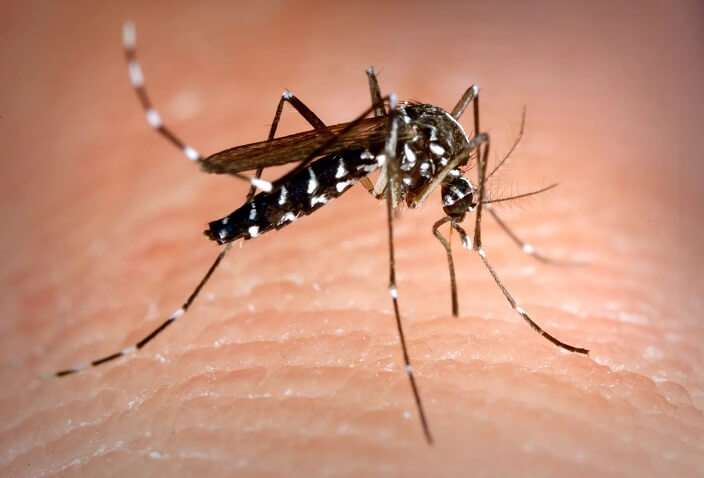
Effective Ways To Naturally Prevent Mosquito Bites & Deadly Mosquito-Borne Diseases
Fight the Bite!
By: Megan Redshaw | Children’s Health Defence
A domestic resurgence of U.S. malaria cases for the first time in 20 years, with predictions the numbers will rise, has created concern over mosquito-borne diseases and how to prevent them.
The Centres for Disease Control and Prevention (CDC) on June 27 issued a health advisory after five malaria cases were confirmed in Florida and Texas. Days later, Florida reported two additional cases, bringing U.S. cases to seven. Globally, malaria is a larger threat affecting nearly half of the world’s population.
Although the CDC advises people to protect themselves from mosquitoes by applying potentially toxic repellents, pesticides, and insecticides, there are many effective ways to naturally prevent both mosquito bites and sickness from the pathogens they carry.
Diseases Spread By Mosquitoes
The most common diseases spread to people by mosquitoes include West Nile virus, malaria, yellow fever, Zika virus, dengue, and chikungunya virus. However, getting sick from a mosquito bite is rare.
West Nile Virus
West Nile virus is the leading cause of mosquito-borne disease in the United States, with 17 cases reported by the CDC as of June 27. Eight out of 10 people infected with West Nile do not develop symptoms. Those who do may experience fever, headache, disorientation, a stiff neck, tremors, convulsions, muscle weakness, numbness, and paralysis.
Malaria
Malaria is a serious and sometimes fatal disease that spreads to humans through an infective Anopheles female mosquito bite. When the mosquito bites, it injects one of five species of protozoan malaria parasites into the person’s bloodstream. Symptoms generally appear within seven to 30 days but can take up to a year to develop.
Although easily treatable, malaria may cause sickness with high fevers, shaking, chills, and flu-like symptoms. Certain species of parasites are associated with more severe illness. Failure to treat the condition could cause chronic infection with relapsing episodes.
Malaria is rare in the United States, affecting only 2,000 people annually who usually acquire the illness through travel. There have only been 150 cases of locally acquired malaria in the past 50 years. Most malaria cases and associated deaths occur among children in sub-Saharan Africa, where conditions are more favourable to the disease.
Zika
Zika is a mosquito-borne disease transmitted primarily by the Aëdes species of mosquito that bite during the day. Symptoms include mild fever, rash, headaches, pain, and conjunctivitis for two to seven days. Currently, there are no medications to treat or prevent Zika.
No cases of locally acquired Zika have been reported since 2016 and 2017 when the CDC and pharmaceutical companies attempted to market a failing Zika vaccine for a condition that was suddenly prevalent in the United States.
Yellow Fever
The yellow fever virus is spread through the bite of an infected Aëdes or Haemagogus species mosquito and rarely occurs in the United States. There is no medical treatment for the disease. Still, most people fully recover in three or four days. Although a yellow fever vaccine has existed for 80 years, it is an attenuated live-virus vaccine associated with severe adverse events.
Dengue
Dengue viruses are spread to humans through the Aëdes species of mosquito. The CDC confirmed 1,188 cases of dengue in the United States last year. However, only 1 in 4 people who acquire dengue will experience symptoms, and most recover within a week.
The Food and Drug Administration (FDA) in 2019 approved the first controversial vaccine for dengue disease for children ages 9 through 16 who have laboratory-confirmed previous dengue infection and live in endemic areas, but there is no medical treatment for the illness.
Chikungunya Virus
The chikungunya virus is spread by the bite of an infected mosquito. Symptoms may include headaches, muscle pain, rash, and joint swelling. U.S. cases are rare, with most acquired while traveling. There is no medication to treat or prevent the disease.
Plan To Release GMO Mosquitoes In California Draws Fire From California Lawmakers, Environmentalists
Preventing Mosquito-Borne Diseases
The best way to prevent mosquito-borne diseases is to prevent mosquito bites. Synthetic chemical repellents may repel mosquitoes, but this may come at a cost to humans and the environment.
DEET & Insecticide Repellents
U.S. regulatory agencies recommend using commercial repellents produced with chemical components such as N,N-diethyl-meta-toluamide (DEET), allethrin, N,N-diethyl mandelic acid amide, and dimethyl phthalate.
Chemical mosquito repellents detrimentally impact synthetic fabric and plastics and cause adverse reactions such as allergies, dermatitis, and cardiovascular and neurological effects. Using synthetic repellents has disturbed ecosystems, contributed to insecticide resistance, the resurgence of mosquito populations, and has adversely affected other organisms. The most commonly championed repellent is DEET—an insecticide.
DEET was developed and patented (pdf) by the U.S. Army in 1946 for military personnel use as an insect repellent. It was approved in 1957 for use by the general public without any restriction on the amount or frequency of application.
The CDC and Environmental Protection Agency (EPA) say DEET is safe, but both agencies have a long history of recommending products proven harmful and carcinogenic to humans.
At large enough doses, DEET can cause symptoms of neurotoxicity (pdf). Neurological symptoms may develop at lower doses with frequent usage over a short time. At lethal doses, twitching, convulsions or seizures, unconsciousness, extreme weakness, and neuropathological lesions in the brain have been observed.
Several other systemic effects in laboratory animals have occurred with frequent use, including microscopic lesions in the liver, kidneys, testes, stomach, bone marrow, thymus, and skin.
When used properly, some researchers believe DEET is safe and effective. However, DEET is present in hundreds of products and, when synergistically combined with permethrin-treated clothing or pyridostigmine bromide, may be detrimental to humans and help chemicals cross the blood-brain barrier (pdf).
Permethrin is a pesticide the EPA and CDC recommend applying to clothes and fabric to repel mosquitoes. According to the EPA, permethrin is “highly toxic” to honeybees, freshwater and estuarine aquatic organisms, and other beneficial insects.
Laboratory studies show permethrin can negatively affect the human nervous system and a child’s developing brain; however, the EPA says their assessments have found the pesticide poses a low risk to human health.
Research suggests simultaneous exposure to multiple chemical agents, including DEET and permethrin, may cause symptoms associated with Gulf War syndrome, such as headaches, fatigue, respiratory disorders, skin conditions, neurotoxicity, and nerve damage. The EPA has not conducted studies to determine whether the synergistic effects of combining these chemicals are safe for humans.
Outside of DEET and permethrin, the CDC recommends picaridin—Bayer’s synthetic insecticide with sparse safety data—IR3535 oil and lemon eucalyptus oil—synthetically derived from para-menthane-3,8-diol. The agency does not recommend using any type of essential oils.
Anti-Malarial Drugs
Malaria is a mosquito-borne illness that has medically approved drugs for prevention and treatment, including hydroxychloroquine, Malarone, chloroquine, doxycycline, mefloquine, primaquine, and tafenoquine. Most of these drugs are taken before travel to other countries where malaria is prevalent.
Hydroxychloroquine, a well-known immunomodulatory drug approved by the FDA has been used for 60 years to treat malaria. Because of its long elimination half-life of 30 to 45 days, weekly dosing can prevent malaria, and a brief 48-hour treatment course can be used to treat the disease once acquired.
Hydroxychloroquine is well-tolerated and associated with few side effects but may cause a rare eye condition if used at higher doses for many years.
Creating An Environment Adverse To Mosquitoes
Creating an environment adverse to mosquitoes is one of the easiest ways to prevent mosquito-borne disease. Some species of mosquitoes like living near people, while others prefer forests and tall grasses; all mosquitoes like warm, humid weather and water.
To create an unfriendly environment for mosquitoes, consider the following:
- Remove standing water from areas around your home.
- Repair damaged windows and door screens.
- Use UV light traps to lure and catch mosquitoes.
- Use air conditioners, dehumidifiers, and fans to reduce warm temperatures and humidity.
- Time outdoor activities to avoid the hours from dusk to dawn.
- Wear long sleeves and pants when working outside.
- Promptly wash off sweat to deter mosquitoes.
- Create an outdoor firepit—as smoke repels mosquitoes.
- Use citronella candles.

Natural, Nontoxic Ways To Prevent Mosquito Bites
Though the CDC recommends using repellents evaluated by the EPA, numerous studies suggest there are safer and equally effective natural alternatives.
In recent years, researchers have taken an interest in plant-based repellents because they contain a rich source of bioactive phytochemicals and insecticidal properties that are safe and biodegradable into nontoxic by-products.
A 2019 systematic review in Malaria Journal evaluated 62 eligible studies on the effectiveness of plant-based repellents against Anopheles mosquitoes that cause malaria. Ligusticum sinense extract, followed by citronella, pine, Dalbergia sissoo, peppermint, and Rhizophora mucronata oils, had the highest repellent effects, with protection ranging from 9.1 to 11.5 hours.
Essential oils from plants such as lavender, camphor, catnip, geranium, jasmine, broad-leaved eucalyptus, lemongrass, lemon-scented eucalyptus, Amyris, eucalyptus, carotin, cedarwood, chamomile, cinnamon oil, juniper, cajeput, soya bean, rosemary, niaouli, olive, Tagetes, violet, sandalwood, Litsea, galbanum, and Curcuma longa also repelled different species of mosquitoes for around eight hours.
Other plants shown to effectively and safely repel mosquitoes include basil, garlic oil, witch hazel, topical apple cider vinegar, and catnip—a common garden herb known for its euphoric and hallucinogenic effects on cats, scientifically shown to be as effective as DEET.
* * *
NEXT UP!
Unusual Diseases Are Killing Animals In Large Numbers All Over America
It isn’t just humans that are being hit extremely hard by deadly pestilences. In recent weeks, I have written numerous articles about the strange diseases that have been causing severe illness and death among human populations in various parts of the globe.
But there are other plagues that have suddenly erupted that aren’t affecting us at all. Instead, they are devastating animal populations, and so they get less media coverage. But the truth is that some of these diseases are extremely serious.
For example, tens of millions of our chickens and turkeys are already dead due to an unprecedented bird flu pandemic. That deeply impacts each one of us, because now chicken and turkey are much more expensive at the grocery store. And one or more of the diseases that I am going to talk about in this article could make the jump to humans, and if that happens we could potentially be facing a big time nightmare.
* * *
Read more on Health News: Researchers Discover Popular Sweetener Damages DNA
Liked it? Take a second to support Collective Spark.
We’d love to hear from you! If you have a comment about this article or if you have a tip for a future Collective Spark Story please let us know below in the comment section.
